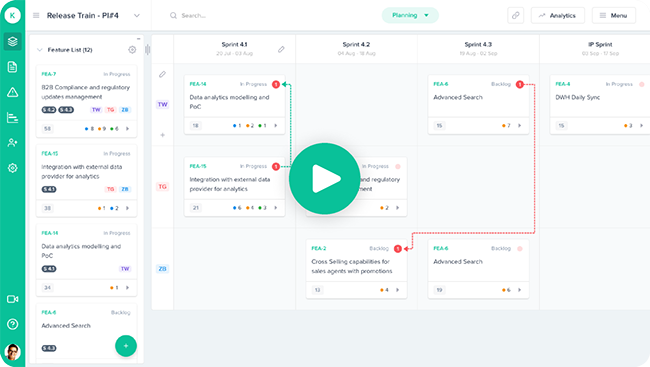Kendis is a digital solution for PI, Tribe and Big room Planning that works on top of Jira and Azure Boards.

Agile Scrum works best with small teams that work to deliver software prioritized by the team backlog. It is then built in iterative models with sprints in the order of highest priority items implemented first. However, when it comes to managing large organizations, Scaled Agile Framework is adopted instead of the plain Agile Scrum.
Certain practices from the waterfall model are tweaked to suit the purpose of becoming Lean and Agile.
These can be identified as follows:
- Centralized control replaced by decentralized decision making
- Enhanced role of the Project and Program Managers
- Detailed project plans replaced by lightweight epic-based business cases
- Adoption of automation & deployment in the enterprise
- Defined work breakdown structure replaced by agile planning
- Defined financial structure
- Increased role and coordination of dependencies and external stakeholders
- Commitment to the team and constant rotation of team members
- Fixed mindset replaced by an adaptable approach to embrace change
In the recent past, Scaled Agile Framework has been adopted by organizations of domain ranging from finance, logistics, insurance and government. Abbreviated as SAFe, the Scaled Agile Framework provides a framework to apply Lean and Agile practices at an enterprise level.
But why use SAFe?
Why are enterprises applying SAFe?
Adopting SAFe is the preferred route for enterprise teams due to a number of unprecedented facilitation features it offers to the users. This article describes the 15 reasons why SAFe is essential for Agile teams and why it should be incorporated to help achieve your business goals:
- Adaptability
Supports quick adaptability to shifts in technological and financial conditions - Collaboration
Promotes collaboration and transparency between all levels of stakeholders by creating a connection, leading to an active interaction between the development team and the c-level executives - Acceleration
Speeds up attaining the business value in the shortest time - Consistency
Ensures consistent approach towards planning, execution and delivery - Scalability
Allows scalability and configurability that suits your business needs, irrespective of the daunting size of the enterprise - Regularity
Sets frequency of cross-Functional Agile Teams deliver working software after every two weeks - Centralization
Agile Release Train (ART) brings together multiple agile teams on a consistent routine for every 8-12 weeks known as a Program Increment (PI) - Cadence-based synergy
The cornerstone of SAFe is Program Increment (PI) Planning cadence-based session where agile teams band together to define the goals they wish to achieve in a fixed time period. This results in having face to face, collaborative, interactive and innovative sessions that build team spirit and synergy - Coordinated strategy
Promotes the sharing of strategy, common, vision and architecture amongst development and the managerial teams bringing all the stakeholders on the same page - User-centric focus
At the end of every release train, there is an inspection of the product from the customers for the quick, first-hand user-based input - Feedback loop
Constant feedback from customers helps maintain a successful business relationship leaving room for improvement throughout the entire process - Dependency management
Continuous integration and validation amongst teams helps in reducing risks and enhanced dependency management at large-scale and complex projects - Faster production cycles
Provides significant improvement in business productivity, quality, employee engagement and time to market - Synchronisation across teams
Usage of Scrum-of-Scrum in the Agile Release Team keeps the team in synchronization with each other avoiding delays by introducing standardised processes and common goals - Innovation
A systemised iterative and adaptive approach, especially responsive to a consistent and efficient feedback loop is one of the core strengths of SAFe









